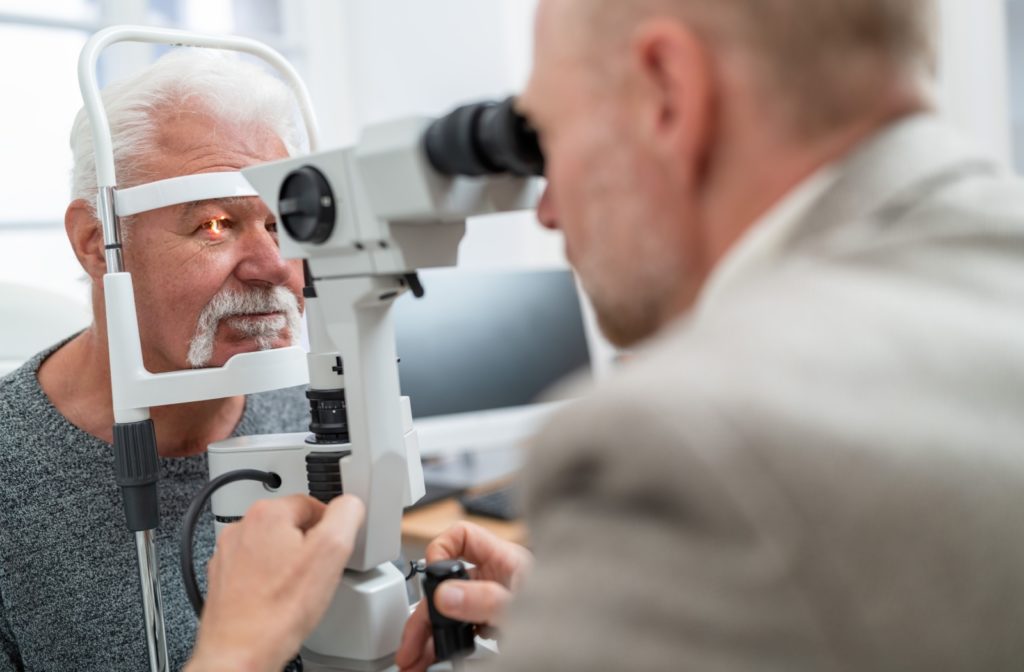Driving at night can be frustrating—especially if your vision isn’t as clear as it needs to be. Glaring headlights, eye strain, or poor low-light vision can make nighttime driving unsafe. This can be caused by all kinds of eye conditions and diseases.
Some common reasons people have trouble driving at night include:
- Astigmatism
- Presbyopia
- Cataracts
- Glaucoma
- Night blindness
- Vitamin A deficiency
Astigmatism
Astigmatism occurs when your eye’s cornea or lens is irregularly shaped. This prevents light from focusing correctly inside the eye. Astigmatism is a common refractive error, and it’s known to cause:
- Blurry or distorted vision
- Halos around lights
- Eye strain or headaches
This can be problematic if you’re driving at night. You might notice halos around headlights or have difficulty distinguishing road edges at night. Fortunately, astigmatism is easy to treat.
Your optometrist can examine your eyes and map your cornea to identify the exact level of astigmatism. Then, they can recommend specialty eyeglasses or contacts for astigmatism to help you keep your vision clear.
Presbyopia
Presbyopia is a common age-related vision problem. It affects the eye’s ability to focus on objects up close and reduces the ability to see in low lighting. This makes driving much more frustrating.
Presbyopia often causes:
- Blurred vision up close
- Difficulty reading small print
- Eye fatigue or strain
- Needing bright lighting
These make it difficult to clearly see at night. You may struggle to see your dashboard or road signs. However, presbyopia can be treated with your optometrist’s help. They can recommend special reading glasses, bifocals, or multifocals to restore your clear vision. These allow you to comfortably focus on objects at different distances and make night driving much easier.
Cataracts
Cataracts occur when the lens of the eye becomes cloudy. This reduces how much light reaches the retina and prevents clear vision. Cataracts often develop slowly and subtly—some people don’t even notice them until their vision changes noticeably.
Cataracts often cause discoloration and yellowing in your vision. They’re also known to cause:
- Cloudy or foggy vision
- Increased glare from headlights
- Sensitivity to bright lights
These issues make driving in low-light conditions unsafe and uncomfortable. There is good news, though—cataracts are easily treatable through cataract surgery. This safely and effectively removes the clouded lens to restore your clear vision.
Glaucoma
Glaucoma is a group of eye diseases that damage the optic nerve. There are several types of glaucoma, each with specific causes and symptoms. Glaucoma is closely linked with increased intraocular pressure that eventually damages the delicate nerves at the back of the eye.
However, glaucoma rarely shows any symptoms at first. It’s difficult—and often impossible—to recognize on your own before it permanently damages your vision. This is a complex condition that requires an optometrist’s help to properly catch, diagnose, and manage.
At first, glaucoma tends to damage peripheral vision. As it worsens, this progresses to also cause:
- Gradual loss of central vision
- Blurry or hazy vision
- Difficulty seeing in dim lighting
- Increased sensitivity to glare
- Decreased color perception
If you notice any of these signs, visit your optometrist as soon as you can. They can test for glaucoma and help you effectively manage the condition going forward. Don’t put your vision at risk—any serious vision changes warrant professional help.
Night Blindness
Night blindness, or nyctalopia, is a condition that makes adapting to dim environments a challenge. It’s not a specific disease—it’s a symptom caused by other underlying eye conditions or disorders.
You can recognize night blindness by poor vision in any low-light environment. You may struggle to see clearly when looking at light sources at night or have trouble seeing in any dark areas.
If you experience significant changes in your night vision, talk to your optometrist as soon as you can. They can determine the underlying cause of your night blindness and suggest an appropriate solution.

Vitamin A Deficiency
Sometimes, the answer is simpler than you think—a vitamin deficiency. Vitamin A is essential for healthy vision, especially in dim areas. A lack of vitamin A can lead to issues like dryness, irritation, and poor low-light vision.
Vitamin deficiencies are also easy to address. You should visit your optometrist so they can determine whether a vitamin deficiency is causing your symptoms. Then, you can incorporate new foods into your diet, such as.
- Carrots
- Leafy greens
- Eggs
- Dairy products
- Fish (such as salmon and tuna)
These nutrient-rich foods help improve vitamin A levels and support healthy vision. If you can’t work these into your diet, you can try vitamin A supplements. However, always consult your optometrist before significantly increasing your vitamin A levels—vitamin toxicity can be problematic, and safety is key.
Let Our Team Help
If nighttime driving is a challenge, don’t leave the problem unaddressed. Instead, come visit our team at Total Vision El Cajon. Our team can examine your eyes and determine what’s causing your vision troubles. We’re here to help you find a solution that meets your needs, so schedule your appointment with us today!


